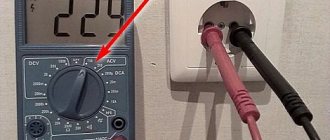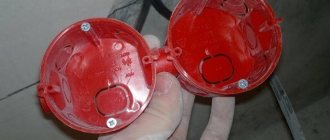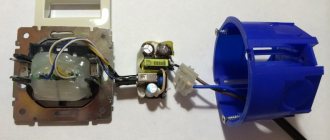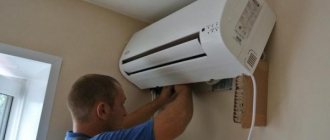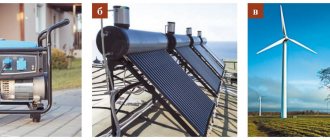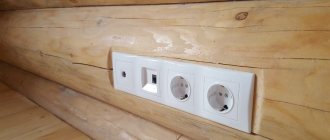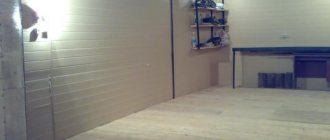Added by: Andrey March 4
Outdoor wiring can be convenient and safe with an outbuilding or outdoor outlet installation.
There are two methods worth trying to make your outdoor use of electricity more convenient and safe. The first is conducting energy to the garden building, the second is installing do-it-yourself sockets for garden tools that run on electricity. Electrical work is fairly straightforward, but before doing it, you must notify your local building code department to ensure it is inspected and approved.
- 2 Overhead cable routing and external sockets
2.1 Laying underground cable
- 7.1 Concealed installation from the outside of the wall
Varieties
A protected waterproof socket is:
According to the installation method, sealed sockets protected from moisture are:
Built-in types of electrical sockets, protected from moisture, have special hidden devices. For closed connectors, an additional hidden socket box is required. Built-in protected double sockets are more aesthetically pleasing than special overhead types of sockets with a switch.
Protected surface mounted electrical outlets have fewer installation requirements. They are installed on the wall, so the surface-mounted socket box will be protected from moisture outdoors. A special hinged lid of the box protects the connectors from rain. To comply with safety standards, single and double surface-mounted sockets are more reliable for outdoor installation than built-in type electrical connectors protected from moisture.
Where to put it and how to connect?
Before installing a socket for a protected design, you need to understand its functionality. For gazebos, the installation of the socket is carried out not on the wall, but inside the temporary structure. For the walls of houses and garages, external electrical products are installed below the canopy to protect them from moisture. To carry out housekeeping procedures on site, you need to purchase connectors sealed in a moisture-proof box.
Installation of the external electrical connector is carried out according to the proven scheme:
Manufacturers of outdoor electrical outlets
The most popular products are from Simon and Legrand. The first brand is Spanish, it has an excellent quality-price ratio. The devices are available in white, grey, black, gold, and their price is 250–900 rubles.
The second brand is French, its rosettes are famous for their original designs, colors, and shapes. At the same time, such products are installed quite easily. Prices start at 300 rubles; for a block of sockets you will have to pay more than 1000 rubles.
Features of street sockets
An outdoor socket will make it easier to use various household appliances and will allow you to do without an extension cord. Externally and in design, street-type electrical outlets are radically different from ordinary ones. Such devices have the following components:
The contacts in sockets for gardens and outdoors are made of bronze, which is an excellent conductor of current. An important rule in the manufacture of devices is that the wires are completely waterproof, for which purpose there are gaskets made of rubber, rubber or silicone in the grooves.
Types of devices
The body of the electrical outlet can be rubber, rubber, or molded from special plastic. Any street socket is waterproof, made using special technology. There are the following types of products by design:
Devices can be single or double. The latter are single sockets connected in one housing. There are even illuminated electrical outlets - they are very convenient, like garden ones, and are easy to spot in the dark. Typically, products do not deteriorate at sub-zero temperatures, and in summer they can work up to +50 degrees Celsius.
Socket protection degree
The right outdoor outlet is designed to resist rain, fog and other moisture, as well as dirt and dust. It must be completely safe to use. There are several classes of moisture resistance, which are designated by the letters IP and various numbers. The first number reflects the level of protection against dust, the second - against water.
All outdoor devices should not be marked below 54/55, and the highest quality products have an IP65 class. They will prevent a short circuit from occurring if dirt or water gets on the surface of the electrical outlet.
The conclusion is as follows: if the socket needs to be installed directly in the air, you need to purchase it with a marking of at least IP65. When the device is placed outside, but in a panel, the class may be lower. The highest possible protection class is IP67, but their cost is an order of magnitude higher.
Buying tips
The purchase of a product must be done carefully. You should not save money and buy an electrical outlet with a low protection class - this risks a fire. It is better to buy a simple but reliable product without saving on price. If you plan to connect several devices, you should choose an outlet block. It will be useful in the country house, in the garage, and can also be installed by yourself.
Source of the article: https://220.guru/electroprovodka/rozetki-vyklyuchateli/rozetka-dlya-ulicy.html
Device placement rules
Any socket, if installed in a place that is constantly flooded with water, can deteriorate over time. Even waterproof devices can be damaged in a downpour, so it is better to place them under canopies. For example, if an electrical outlet is installed on poles, metal “visors” are pre-mounted on them.
Another way to protect the device is to install it in special boxes or shields. The height of the location should not allow water to penetrate from melting snow or streams during rain. Another important rule is to make the input cable into the socket from below to reduce the risk of moisture getting into the opening. You should also evaluate the ability of the surface where the outlet will be located to catch fire - it should be minimal.
Wiring parameters
A short circuit in a street electrical outlet can be caused by incorrectly installed wires. Soldering and twisting should not be allowed; all cables must be strong and solid. If soldering of wires is necessary, special couplings should be used. When the insulation layer is thin, a cable duct, corrugated pipe, and sleeves should be placed on top of the cables.
Connecting the socket
The installation process will be different from installing home devices. You definitely need to buy an RCD - a residual current device that will reduce the risk of fire and electric shock. If the electrical outlet is damaged, the RCD will cut off the power. The installation process is as follows:
It is best to connect underground cables with reliable insulating materials to street electrical outlets. The machine must be designed for 220–240 volts. All devices plugged into sockets must be turned off immediately after completion of work.
Electrical connection
The outdoor outlet must be connected with a cable designed for outdoor use. But even in this case, it is better to protect it with a metal hose or black corrugation. This is the color used to indicate corrugation, which is resistant to ultraviolet radiation and suitable for outdoor use in a wide range of temperatures.
When inserting the cable into the socket, you must make sure that the input is sealed. Otherwise, using a device with a high IP makes no sense.
Important! Almost all street sockets allow cable connections both from above and from below. It's better to use the second option. There is less chance of water flowing into the outlet during rain.
These are all the recommendations that you need to follow to make using an outdoor outlet convenient and safe. And finally, a photo from the “how not to do it” category.
Source of the article: https://zen.yandex.ru/media/lampexpert/5-poleznyh-rekomendacii-dlia-rozetki-na-ulice-5fb79ed734b6a25924b7349c
Country electrics in the open air
Electrical equipment operating outdoors is often used at a summer cottage. Pulling an extension cord is inconvenient and unsafe, especially if the area is large. It is much more practical to be able to connect the device to an outdoor outlet.
Light garden buildings - gazebos and open verandas - often need electricity. How to choose country electrics and install them correctly?
Grounding
Electrical appliances plugged into this outlet will be used outdoors, which means that the person handling them will be at increased risk by standing on bare and usually damp ground. The slightest malfunction and you can come under life-threatening voltage. Therefore, a street outlet must necessarily have a grounding contact connected to the house grounding circuit.
Important! The grounding contact must be connected exactly to the ground loop, and not “hung” to zero. The second option is more dangerous than if there were no grounding at all.
Outdoor sockets for dachas
For outdoor use, sockets with dust and moisture protection class IP55 are suitable (almost complete dust protection, protection from water jets from any direction). They have protective curtains, a cover, sealed cable entry and grounding. Under the roof - in gazebos and on verandas - you can install IP44 or 54 sockets (protected from dust and splashes). There are sockets on sale with a protection class up to IP66, completely sealed and withstanding even sea waves, but it hardly makes sense to buy them for a summer house: this is an unjustified expense, given their high price. Sockets with light indicators are convenient for giving, but this option makes them more expensive. According to the installation method, sockets are divided into surface-mounted and hidden-mounted. In country houses, the former are most often used, since they do not require cutting into the wall and hidden wiring.
Outdoor dust and waterproof sockets
Protection class
Conventional household sockets that we are used to seeing at home have virtually no protection from the environment. It’s just hard to get your fingers into it (IP20), but there’s plenty of dust and moisture here. It doesn't even have a lid! Under no circumstances should such an outlet be installed outdoors. If we want to install it under a canopy, then we choose a device with class IP44 (protection against penetration of solid objects larger than 1 mm and splashing water). If outdoors – IP65 (completely dustproof, protected from water jets from any direction).
Healthy! The environmental protection class may be higher than recommended. This will only add safety when using the outlet and extend its service life.
Requirements for installing an outdoor outlet
It is advisable to have a canopy over the outlet for additional protection from water and snow. The outlet should be positioned at such a height that even in the snowiest winters it is above the snow level. Attach the socket only to a non-flammable surface; If this is not possible, be sure to insulate the outlet with non-flammable material. The cable to the socket should be routed strictly from below so that water does not flow down onto the housing.
Grounding of the street outlet is mandatory. A separate circuit breaker and RCD (residual current device) for street electrics must be installed in the electrical panel. The rated current of protective devices depends on the power of the connected devices; the rated differential breaking current of the RCD in this case is no more than 30 mA.
An alternative way to install sockets is in a special IP54 electrical box with a lock. In this case, the requirements for the protection class of the sockets are lower, and the safety is higher; moreover, the box prevents unauthorized access to the sockets. There are also special devices on sale - decorative posts or garden lights with built-in sockets. They can be located anywhere on the site, but most often the height of these devices is not sufficient to comply with the requirement for sockets to be located above the snow level.
Column with rosettes
Cabling
When laying cables underground, you should keep in mind that such work is regulated by the PUE (Electrical Installation Rules). If installation is carried out directly into a trench, then the only option permitted by the PUE is a special armored cable for laying in the ground (for example, VbbShV, AVBbShv, PvBbShv). In swampy areas, on highly heaving and corrosive soils, it is strictly not recommended to lay cables directly into the ground. Laying other types of cables, for example VVG, is possible only in special corrugations or pipes, regardless of soil characteristics. Single-wall and double-wall products made of HDPE (low-density polyethylene) are considered optimal for cable protection. This material has good electrical insulating properties, high strength and durability, its service life is up to 50 years. Laying cables in steel pipes is strictly prohibited. When determining the cable route, you need to take into account the requirements of the PUE for safe distances to various objects. Thus, you cannot lay cables closer than 1 m from communications: water supply, sewerage, drainage system, gas pipeline. It is undesirable to cross with other cables and pass under areas with heavy ground load or frequent excavation work. The distance to large trees should be at least 2 m, shrubs - 0.75 m, buildings - at least 0.5 m. The minimum cable laying depth according to the PUE is 0.7 m; on cultivated lands and for high-power cables it is advisable to increase it up to 0.9–1 m. It should be taken into account that the depth of the trench should be greater, since a sand cushion 10 cm thick is placed at its bottom. The cable must be solid, without joints, along the entire length of the installation; the corrugation or pipe must also be solid or with a minimum number of sealed connections. When laying the cable, you must ensure that it lies freely, without tension. After finishing the work, it is covered with a 10 cm layer of sand and soil. A warning tape is laid across the soil surface.
Never leave outdoor outlets energized when you are not using them. Make it a rule to turn on the current immediately before connecting electrical equipment and turn it off immediately when you finish work.
Source
Drawing up a diagram before installation
First you need to calculate the number of lamps and switches, and sockets for them. Next, determine where powerful electrical appliances will be installed, such as a boiler, boiler, or electric stove. This will allow you to calculate the length of the cable and draw up a diagram of the electrical panel in the country.
It is worth noting that all electrical installations (facilities) built and reconstructed after 2003 must have grounding (specified in a number of paragraphs, for example, 1.1.1., 1.7.102-103., 7.1.13., Chapter 1.7., GOST R 50571.3 -94, etc.). This means that if you are building a summer house now, you need to draw up a wiring diagram with grounding. If you have an old dacha and you are just making repairs, it is permissible to leave the circuit without grounding, which we do not recommend.
In order for the electrical wiring to be correct and serve for a long time, it is necessary not only to lay it correctly, but also to select the correct cross-sections of the conductors and the ratings of the machines. The question arises: how to choose the cable cross-section for your dacha and assemble an electrical panel with your own hands?
You need to select a cable for the load power. One of the common rules is to use wires and cables with a cross-section of 2.5 square meters. mm for sockets, and for lighting - 1.5 sq. mm. For an accurate calculation, use the calculator on our website. A 10A circuit breaker is enough for lighting, and 16A for sockets. If we talk about the RCD, then its nominal value is higher than that of an automatic machine. Let’s say the machine is set to 16A, which means the RCD is set to 25A. Based on the leakage current, the RCD is selected depending on its purpose: for the bathroom it is better to set it at 10 mA, to protect the entire “wet group” at 30 mA.
Now check out the selection of typical electrical panel diagrams for dachas:
Diagram of a simple panel without grounding with a single-phase 220V input:
Input diagram for 1 phase with grounding:
Scheme with three-phase input 380/220V and grounding:
Street sockets: features and rules for bookmarking 16
Outdoor sockets are designed for use outside the house, which provides convenience in connecting equipment. In the article we will consider the features, technical characteristics of devices and installation rules.
Features of installing street sockets
Outdoor sockets are manufactured taking into account safety parameters and protection in the external environment from adverse events. Their installation is practical for connecting lawn mowers, garden equipment and appliances to the electrical network. This simplifies the task of using wiring and carrying.
Outdoor electrical sockets are usually made of high quality steel, but all additional elements are made in accordance with standard safety regulations. Such devices are installed on a solid base, for example, on concrete, soil or tiles, as well as in gazebos, on a veranda or platform.
Very often, clients prefer to install electrical devices to control the switching on of street lighting. This is necessary so that in the evening you can easily turn on all the lights in the yard, as well as adjust the brightness of the light bulbs in the garden. As a rule, you can manage the overall system in several ways:
The choice of one of the control systems depends on the characteristics of the individual model, as well as its parameters, illuminated area, and so on. It is worth noting that in a large area it is easier to control everything remotely from home, and in a small area you can install an outdoor outlet.
All control systems are shown to make it easier for the owner to decide on an outdoor electrical installation system. It is best to install a block of street sockets, which will allow you to control all devices, both lighting and connection items, such as electric saws, mowers, and so on, from one place.
One of the varieties is the purchase of waterproof sockets, which ensure the safety of the electrical network from the adverse effects of natural phenomena and factors. For example, a high-quality device must withstand temperature changes and be protected from moisture and dust, which is very important in places where excavation and irrigation are carried out.
Outdoor waterproof sockets must be made in such a way as to avoid external interference, and also so that children cannot reach them. One of the safety rules is to install a metal case that is securely fastened. It can be designed for 2 or 4 sockets, which are standard connectors. For a better security system, models with a waterproof level are installed.
Outdoor sockets with moisture protection level
To ensure safe operation of an electrical outlet outdoors, it is recommended to install devices with a high level of moisture protection. According to the standards of the International Electrotechnical Commission, a street socket, as well as a switch, must have a certain class of protection from moisture and dust. For example, for a socket that is located in a panel or box, the class is designated as ip44. For an open device, the marking class is different - ip54/55, and the most popular and widely used are outdoor sockets ip65.
Explanation of the markings and security class of the device:
As a rule, street sockets are produced and manufactured only for outdoor use. After all, all characteristics and parameters are calculated for the external environment.
Installation locations for street sockets
Devices are most often installed in the following places:
The main thing to remember when installing is that sockets designed for indoor locations are not suitable for outdoor use. Such devices have a low degree of moisture protection, which can cause a failure in the electrical power supply at home and the like.
Features of connecting a street outlet: rules
Considering the fact that the socket for outdoor installation has a durable casing and level of protection, it is still necessary to follow the installation rules and know some features, which include:
Choosing the right outlet location
It is recommended to make sealed street sockets under a roof, canopy, canopy or other hanging structures. All this is important to take into account so that the device does not flood with water, because even an IP65 system can be significantly damaged in heavy rain. Therefore, all systems must be installed in protective boxes or shields. Also, a sufficient height of the socket must be selected. This is important so that it does not become flooded or flooded in the wrong location.
Features of installation to the cable:
All electrical installations adapted for the street have two inputs - lower and upper for connecting the cable. To avoid problems with the electrical network, it is recommended to install the cable through the lower opening. Because the top connection may be flooded with water, even including the wire sealing ability.
Accounting for wiring parameters in the house
There may be nuances in the wiring that allow moisture to seep in and cause a short circuit, and these include solders and twists. Therefore, in the process of installing outdoor garden sockets, a single piece of wire is used, and couplings are also additionally attached to solder the cable. For wiring or cables that have a thin layer of insulation, a metal sleeve or corrugated pipe, as well as a special cable duct, are used so that the entire wiring system is properly protected from damage and exposure to natural phenomena.
Note! When installing the device for outdoor use, it should be placed on a non-flammable surface. If there are such areas, the installation should be accompanied by a layer of insulation with non-flammable properties, which will protect it from contact with other devices.
Design features of street sockets
Determining the characteristics from the influence of the external environment, as well as for protection from moisture or dust, determined some parameters of the socket elements:
In stores you can see sockets that have completely molded rubber casings. Such products are made of rubber and are intended for cable extension cords and their kits.
Rules for installing a street outlet
The waterproof socket is perfect for outdoor installation. Some use it for work, while others use it to connect Christmas lights, street lights or other electrical tools.
The installation process is different from the indoor installation method. This is due to the need to contain safety rules from external factors, as well as the practicality of the location. Let's consider the question: how to properly install a street outlet, taking into account all the rules? First of all, you should choose a place for installation with a set height under the cover to avoid problems.
Rules for laying underground and overhead cables
To lay a terrestrial cable, you must adhere to the following rules:
1. A standard PVC polymer sheathed cable can be laid if the total length is up to 3 meters.
2. The need for a longer cable must be accompanied by additional tensions as well as couplings, and such a wire must be installed with a grounded contact near the building. In this case, the distance above the ground may be more than 36.5 meters, and below the ground approximately 52 meters or more. Only taking these parameters into account will it be possible to connect a street outlet. The price of such wiring will be higher than usual.
For underground cable the following conditions must be met:
1. The cable that is laid underground must be equipped with a polyvinyl chloride insulating pipe. It must be soldered using solvents and some parts and elements that will ensure a continuous supply of current.
2. The cable of such an installation is laid in the ground. Under a terrace or courtyard the depth should reach 4.5 m, and under flower beds or lawns up to 7.5 meters in depth.
Installing an outlet with a grounding contact
The socket should be installed with a grounding contact, and the connection parameters to the building’s grounding loop should also be taken into account. It is also recommended to attach a special protective shutdown device to the wiring or cable, which leads to the street outlet. In some cases, an RCD will help protect against fire or electric shock that can occur through a damaged wiring surface or outlet.
It is worth remembering that the device is designed for a certain power, so it is important to immediately determine the connected tools. For additional protection, it is recommended to purchase a circuit breaker.
Installing a street socket with your own hands
The socket installation process is as follows:
1. Work must begin with identifying the inlet.
2. Install an outdoor outlet so that you can make a hole in the wall and place the electrical wiring closer to the indoor outlet.
3. After fixing the box to the output space, and after describing the circuit, connect it to the protective terminals of the device.
4. The panel must be secured to the box to ensure proper atmospheric pressure protection.
5. Route the wires to the connection point through the protective shutdown passage, if necessary.
Connecting to a power source
The surest way to run electricity to an outside outlet is to run a 240-volt circuit from the main panel in the house to an additional panel in the desired building. Once the circuit is laid, already near the external outlet it can be divided into different voltage levels, for example, 240 volts and 120 volts.
In this system, it is better to use an underground cable of the required length, and for safety reasons, protect it with insulating material to avoid external damage. The installed circuit breaker must also be rated for 240 volts. Outdoor socket, the price in some stores may vary depending on the power.
In many homes, it is compliant to install a booster switch rated at 20 or 30 amps. But first, you need to make sure that this installation system can withstand such an amplifier. In order not to make a mistake, you should call for help an electrician or a specialist who will consult on all the safety measures for installing a street outlet, whose photo (and video) will show you an easy way to install the device in your garden or yard.
It is worth remembering several ways to install a street outlet, taking into account all the parameters of use and safety. In the first case, this is the conduction of electric current to additional structures on the site, and in the second case, this is the conduction of electricity for working with equipment or other garden tools. All work is carried out simply, but at the beginning it is important to inform the local office in the area in order to carry out all installations according to regulations, observing safety precautions.
Source
Comments:
Skept
As for me, it’s better to run the cable out of the house than to fence off an outlet on the property. Rain, snow, frost, dew are not the best friends for electricity
Andryukha
Skept, we are not talking about the fact that these sockets will be constantly connected to the network. They are usually connected to a separate package and work only in the dry season. Feed the gazebo or irrigation system according to schedule. You can, of course, pull the extension cord from your house to the gazebo every time you want to drink tea there, but it’s much more convenient to turn on the machine in the house and connect there.
Valentine
In the case of an outdoor outlet, I would not buy IP 66, because... it will still not be completely immersed in water, and there is no reason to pay twice as much for such functionality. If the socket is lying in a puddle, no matter how protected it is, I won’t not only plug it in, I won’t even touch it if it’s energized at the time
Jamis
For some reason, no one talks about protecting the person with the street socket. It seems that the text was written in 90. Firstly, it is imperative to install an RCD with a 5mA cut-off, like for a bathroom. And secondly, it is necessary to use an isolation transformer to eliminate the possibility of severe electric shock. If you do not use a 220V electric tool, then the best thing is to use safe voltages of 12 or 36V. Fortunately, there are plenty of such lamps in stores.
Leave a comment Cancel reply
Related Posts
German ABB sockets combine reliability and stylish design. How to choose a hidden wiring socket, practical advice.
Retro sockets - design element or functional detail?
What features does the Legrand switch have and how can you connect it?
